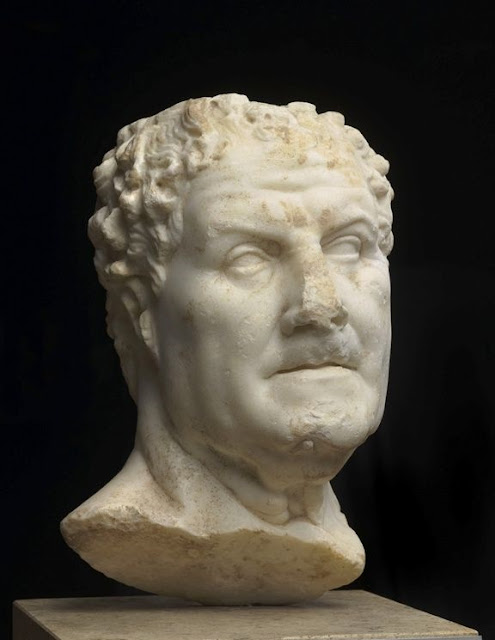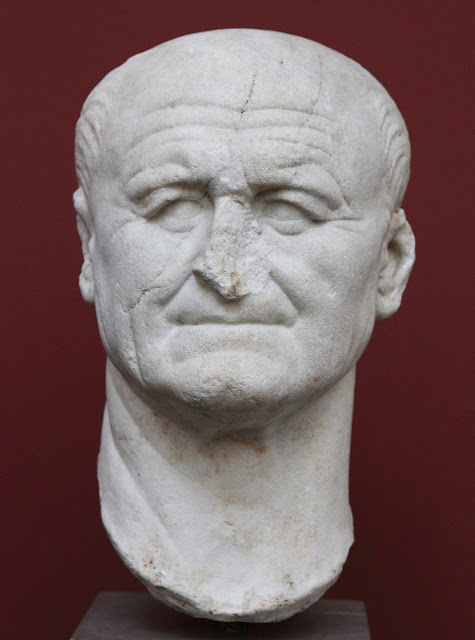 |
| Roman workshop Head of anonymous aristocrat / politician late 2nd century BC marble Musée du Louvre, Paris |
"This period of social change and cultural liberalization also saw the development of the "realistic" portrait, which is rightly considered a characteristic genre of Roman art. But here too we have to reckon with a number of coexisting approaches to portraiture, all of which have their roots in Hellenistic art. This is not surprising, given that Greek artists were working for the Romans in this genre too. Clients could choose, at one extreme, expressive images that were full of movement and powerful emotion, or, at the other extreme, realistic images that included every tiny blemish, or any of dozens of hybrid forms in between. A good example of such a hybrid form is a portrait (of which we have several versions) showing an unidentified aristocrat of the late second century BC. His facial expression, full of determination and energy, and the vigorous swing of the head obscure the fact that he is an old man. Nevertheless, the face, with its wrinkles, the bags under the eyes, and the toothless mouth, is extremely realistic. The coiffed hair shows that he was not unaffected by Hellenistic fashion. The formulae for emotional engagement employed here, such as the slightly inclined head, tense facial features, and partially open mouth, are all taken from the repertoire of Hellenistic art."
 |
| Roman workshop Head of Pompey Augustan copy of 70-60 BC original marble Museo Archeologico, Venice |
"The quieter, calmer portraits of Pompey, by contrast, attempt to combine the Hellenistic tradition of emotional engagement with the ideals of the Roman citizen. [That above] depicts the great general and politician in a purely Hellenistic style using the usual formulae for energy and charisma, which to a modern viewer seem almost to give him an air of sadness. The later image [below] combines an allusion to Alexander the Great – in the form of the anastole, the hair springing up over the forehead – with the realistic and traditional facial traits of a Roman citizen. The incoherence of this combination might almost be a metaphor for the contradictions that riddled Pompey's political actions and indeed late Republican culture in general."
 |
| Roman workshop Head of Pompey ca. 60-50 BC marble Ny Carlsberg Glyptotek, Copenhagen |
"A special characteristic of the best images of this period is that they try to convey not only the patron's physical features but also his character. The image of Caesar [below] from the forum of the town of Tusculum, was probably made during the dictator's lifetime. The realistic depiction of an aging man with deep furrows and thinning hair agrees with the images on coins minted in 44 BC, and may well have corresponded to the actual appearance of the fifty-six-year-old. Unlike Pompey's images, this one avoids all hints of emotional engagement, showing instead the haughty, aloof expression of an aristocrat. The suggestion of an ironic smile and the slightly narrowed eyes seem to have been characteristic of Caesar. One must bear in mind, however, that only mediocre marble copes of this portrait have survived."
 |
| Roman workshop Head of Julius Caesar ca. 44 BC marble Museo di Antichità, Turin |
"The "realistic" portrait that dispensed with all these Hellenistic formulae only developed during the last decades of the Republic, but it quickly became the more popular form. The dominance of this unromantic reproduction of a person's physiognomy, which aimed to include all distinctive features, seems to be connected to the specific self-image of many contemporaries. In the Greek towns, the traditional tendency to idealize and rejuvenate the client's features was still dominant, even if the person in question was already very old. The competitive politicians at Rome, by contrast, were interested in presenting themselves as unique individuals. We may also take it that such harsh realism was well suited to depicting Roman values such as severity and authority."
 |
| Roman workshop Funerary relief late 1st century BC - early 1st century AD marble Musei Vaticani, Rome |
"This funerary relief from the Augustan period was fixed into the wall of a tomb facing the street and shows a married couple, both of freedman status. The father, Hilarius, is wearing a toga, while his wife, Eune, wears a chiton and palla, worn over the head as befits a married woman. To the spectator's left is their son Globulus, represented in the same format and wearing a bulla around his neck as a symbol of his status as a freeborn Roman citizen. Parents and son are separated by the upper portion of a pilaster with a Corinthian capital. When the relief was in situ in the tomb wall, this would have made them appear to be looking down on passersby through windows."
 |
| Roman workshop Funerary relief 2nd century AD marble Skulpturensammlung, Dresden |
"A butcher is shown at work in his shop, with the choicest cuts of meat hanging up behind him. We must assume that his wife, shown to the left, is actually inside their house. She is sitting on a thronelike chair and seems to be writing on a diptychon (wax writing tablet). The hairstyle, clothing, and furniture suggest prosperity. We can see that the butcher was trying to emphasize the status he had attained, despite his less-than-prestigious profession. The sculptor endeavored to reproduce the different cuts of meat and the high standard of the shop as accurately as possible and also tried to convey the family's acquired wealth. The fact that the two spheres of life represented in the image are not clearly differentiated may tend to puzzle modern viewers."
 |
| Roman workshop Funerary relief ca. AD 100 marble Musei Vaticani, Rome |
"Funerary relief of a circus official who wanted to remind passersby of himself and his profession, and also of his wife, who had predeceased him. The sculptor quite inventively solved this tricky problem, for which no model solutions were available. He rendered a charioteer in the foreground with the circus behind him, all in considerable detail, and he located the couple on the extreme left. The deceased is presented as a stern Roman citizen wearing a toga. His wife, represented at smaller scale, is standing on a pedestal beside him. This suggests that we are to see her as a statue with which she was honored after her death (or, more likely, with which she would have been honored if her husband had been able to afford it). Although she is represented as a statue, the two are joined in a formal handshake showing their mutual affection and marital harmony."
 |
| Roman workshop Togate statue of Augustus before AD 14 marble Museo Nazionale Romano (Palazzo Massimi), Rome |
 |
| Roman workshop Togate statue of Augustus (detail of head) before AD 14 marble Museo Nazionale Romano (Palazzo Massimi), Rome |
"The emperor is represented making an offering to the gods, with covered head. His right hand originally held the patera (libation dish, for pouring wine offerings). The head is fashioned from marble of a higher quality than the rest of the statue, and it was carved by a much more accomplished sculptor. This discrepancy shows that statues of emperors were already being mass-produced under Augustus and that the workshops employed specialists for the different parts. The fact that the head is slightly too small in proportion to the body may indicate inaccurate measurements taken during the production process."
 |
| Workshop on Crete Cuirassed statue of Hadrian, with foot on defeated barbarian ca. AD 117-138 marble Archaeological Museum, Istanbul |
"The workshops used well-known models for the different basic types of statues. The torsos were standardized and expressed the merits and character traits of the honorands in an abstract manner: they were not intended to represent the actual bodily form of the honorand. The emperor's function as a model citizen and magistrate was represented by the toga; his abilities as a military commander by the cuirass; his indefatigable presence all over the Empire by his 'traveling-attire' consisting of a short tunic and a cloak; his auctoritas and his resolute treatment of enemies and the vanquished by the equestrian statue. The nude or seminude torsos of gods or heroes from the repertoire of Greek art continued in use after their introduction in the late Republic but now alluded to the emperor's proximity to the gods: the emperor's role in this context was generally understood to be that of a mediator between mortals and immortals. If we disregard negligible extensions to this catalogue of types, and one or two preferences that developed under particular emperors or in certain parts of the Empire, then these basic types continued to be deployed well into late antiquity."
 |
| Roman workshop Frieze fragment ca. AD 40 marble Museo Archeologico Nazionale, Ravenna |
"This relief is part of a longer frieze that once adorned a monument in honor of the Julio-Claudian dynasty. It shows a gallery of statues representing various members of the dynasty. In total there must have been at least seven statues, since we can assume that the statue of the deified Augustus (Divus Augustus, on the far right) originally formed the centerpiece. He is represented as Jupiter in the pose of a ruler, with a cloak slung negligently about him. In his right hand, he held a symbol of universal authority. To the left, the image of Livia draws on the Classical Greek model for Aphrodite. The Eros on her left shoulder emphasizes the identification with the goddess. Farther to the left is a Julian (or Julio-Claudian) prince, who had evidently already died and been placed among the stars for his merits, as indicated by the star carved in his hair. It has been suggested that the figure in the molded cuirass beside him is Augustus's son-in-law, the great general Agrippa."
| Roman workshop Head of Nero, from colossal statue mid-1st century AD marble Glyptothek, Munich |
"In his last years, Nero increasingly saw himself as an artist of unrivaled talents. This subjective view comes across strongly in his final portrait type. Unlike his predecessors, Nero is not depicted with idealized features and a Classical hairstyle but rather with his own full, rather fleshy face and a hairstyle that could only have been made with a curling iron."
 |
| Roman workshop Head of Vespasian ca. AD 70 marble Ny Carlsberg Glyptotek, Copenhagen |
"Vespasian was relatively old when he became emperor, and he could not lay claim to a long family tradition with divine ancestry. His portrait speaks of hard work and sober determination, thus expressing a self-image that differs significantly from the idealized youthful features of Augustus and other Julio-Claudian rulers and princes."
 |
| Roman workshop Bust of Lucius Verus ca. AD 161-169 marble Musei Capitolini, Rome |
"Lucius Verus, co-emperor with Marcus Aurelius, was well aware of fashion and loved luxuries. Although his portrait adheres to the general principles of his family's aristocratically aloof images, his extravagantly curled hair – which he allegedly sometimes sprinkled with gold dust – emphasizes his personal elegance. Such an image is not just a portrait but also an especially striking example of a very specific period taste."
 |
| Workshop in Pergamon Head of Augustus early 1st century AD marble Archaeological Museum, Istanbul |
"Head of Augustus from Pergamon, for insertion into a statue. In the provinces, the images that came from Rome were often changed and adapted to local styles. Full of emotion and energy, the turn and inclination of the head reinterprets the classicizing model from Rome in the tradition of Hellenistic ruler-images. It thus completely transforms the original intention of the portrait-type."
– Paul Zanker, from Roman Art, originally published in 2008, translated by Henry Heitmann-Gordon and published in English by the Getty Museum in 2010